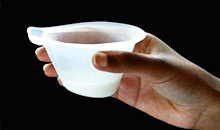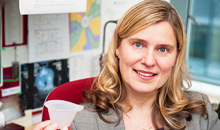Low-Tech Fix to Deadly Issue
Complementary expertise of three Seattle organizations creates a feeding device that could save infants in low-resource areas.

Photo credit: PATH/Patrick McKern
A fruitful collaboration among three Seattle organizations with similar goals and complementary expertise has produced a low-tech device to address life-threatening malnutrition for babies in low-resource settings who cannot breastfeed.
Seattle Children’s, the UW School of Dentistry and PATH joined forces to develop the Neonatal Intuitive Feeding TechnologY (NIFTY) cup, a simple, inexpensive, easy-to-clean, hand-held device that helps babies safely lap up milk. The cup could provide a solution for the millions of babies born each year in Africa and South Asia who can’t breastfeed due to orofacial clefting, prematurity and other infant or maternal health issues.
After receiving a $250,000 validation award from Saving Lives at Birth: A Grand Challenge for Development in 2015, the team is taking the next steps in the device’s development: studying its effectiveness in Ethiopia, developing business and global advocacy plans, and identifying a commercial partner to help scale up production of this simple intervention to a heartbreaking problem.
Meeting a need
 The spark of innovation began five years ago when epidemiologist Dr. Christy McKinney returned to the University of Washington (UW) for postdoctoral work and was searching for a project on the intersection of global health, nutrition and oral clefts.
The spark of innovation began five years ago when epidemiologist Dr. Christy McKinney returned to the University of Washington (UW) for postdoctoral work and was searching for a project on the intersection of global health, nutrition and oral clefts.
“In the literature on neonatal malnutrition in low-resource settings, there is little about babies who have difficulty breastfeeding and are physically unable to feed. It is presumed mothers will breastfeed and that’s not always possible,” notes McKinney, a former doctoral student in Seattle Children’s Craniofacial Centerwho will be joining Seattle Children's Research Institute and the UW Divison of Craniofacial Medicine in the Department of Pediatrics in July. “The World Health Organization and UNICEF recommend hand expressing breast milk and cup feeding babies – but there is no standard feeding cup.”
McKinney met with Dr. Michael Cunningham, medical director of Seattle Children’s Craniofacial Center, who was thinking along the same lines after witnessing the devastating impact of infant malnutrition on children with cleft while working in Africa with PACT – a program he co-founded with Dr. Richard Hopper to help health professionals in Africa create self-sustaining programs to treat cleft.
Cunningham and McKinney reached out to PATH, a Seattle-based organization dedicated to spurring global health innovation. “I sent them an email saying, hey, we have this interesting idea and we’re wondering if you want to hear more. And they said sure,” recalls McKinney.
Eager to collaborate
 “Seattle somehow breeds a creative environment of low-key people who aren’t afraid to share their ideas. I’ve had so many experiences where you get the energy going and you have no trouble getting others involved,” says Cunningham. “You don’t hear ‘what’s in it for me?’ It’s more about ‘this is cool. Let’s come together and work on it.’”
“Seattle somehow breeds a creative environment of low-key people who aren’t afraid to share their ideas. I’ve had so many experiences where you get the energy going and you have no trouble getting others involved,” says Cunningham. “You don’t hear ‘what’s in it for me?’ It’s more about ‘this is cool. Let’s come together and work on it.’”
After a couple of introductory meetings, PATH joined the project. Seattle Children’s Craniofacial Center and PATH each kicked in $15,000, and the team set out to design an innovative feeding tool suited to the setting in which it would be used. It needed to be inexpensive, easy to use and clean, shaped so a woman could hand express breast milk directly into it, and have a reservoir at the lip that allows the baby to control the rate of intake.
PATH’s multidisciplinary team, led by Dr. Patricia Coffey, brought product development, public health and commercialization expertise to the table. Robin Glass, an occupational therapist and lactation expert at Seattle Children’s who specializes in feeding problems, brought a practical perspective to the team.
“The variety of skill sets and expertise on the team resulted in an excellent collaboration,” notes Coffey. “Our team is passionate, fun, lively and willing to go the extra mile without complaint. When last year’s Saving Lives at Birth contest specifically asked for proposals on feeding, warming and care of preterm babies, I knew the NIFTY would be a strong contender.”
Early results
The team was encouraged by results from small-scale initial testing in South India, where women preferred the NIFTY cup to a commonly used tool called a paladai, which looks like a miniature metal gravy boat.
“This project has my heart,” says McKinney, a one-time Peace Corps volunteer. “I’ve always envisioned my research in the translational-to-impact space and the NIFTY definitely fits that bill. It has the potential to make a difference for so many vulnerable babies.”
See how the NIFTY Cup helps newborns feed.
Seattle somehow breeds a creative environment of low-key people who aren’t afraid to share their ideas.
– Dr. Michael Cunningham